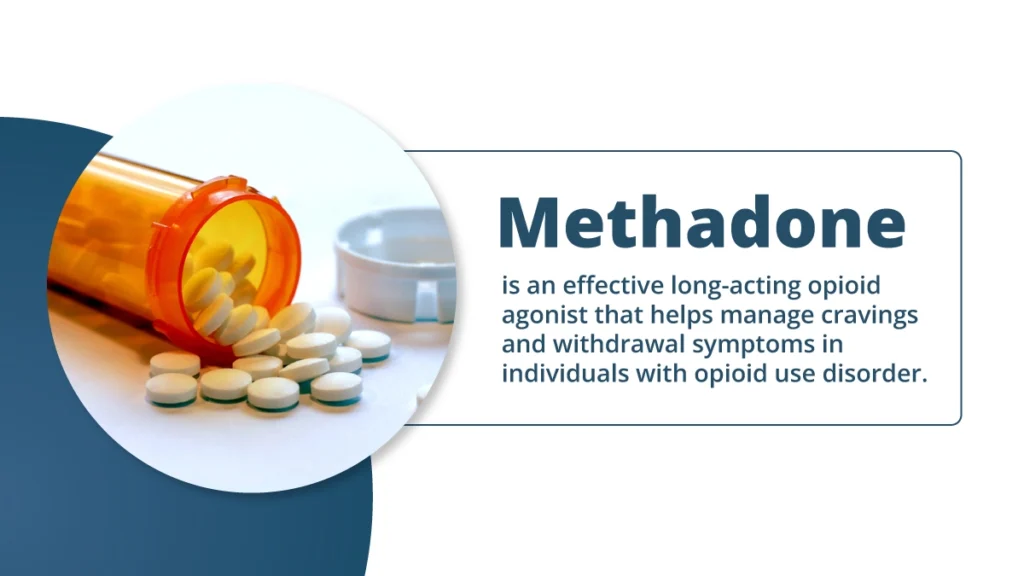Methadone’s efficacy in reducing opioid cravings and withdrawal symptoms is noteworthy, while its use is not without concern. Given its opioid nature, there exists a potential risk of abuse and addiction.
Understanding the nuanced dynamics of methadone in treating OUD is imperative to navigate its potential pitfalls and harness its benefits responsibly.

Key Takeaways
Methadone is a synthetic opioid used to treat addiction, but it can be abused and cause dependence. Here’s what to know:
- Methadone is an effective long-acting opioid agonist that helps manage cravings and withdrawal symptoms in individuals with opioid use disorder.
- Properly administered methadone maintenance therapy can reduce illicit opioid use, improve social functioning, and contribute to long-term recovery.
- Close monitoring, individualized dosing, and comprehensive counseling are crucial components of successful methadone treatment plans for opioid use disorder.
Contact The Haven Detox-Little Rock at (501) 271-3342 for personalized assistance and long-term drug recovery.
What is Opioid Use Disorder
Opioid Use Disorder (OUD) is a chronic medical condition characterized by compulsive use of opioids despite harmful consequences. Individuals with OUD experience a persistent pattern of opioid use, leading to physical and psychological dependence.
Common opioids include prescription painkillers like oxycodone and illicit substances such as heroin. Symptoms of OUD range from cravings and tolerance to withdrawal symptoms when not using opioids.
The Health and Social Impact of Opioid Use Disorder
Opioid Use Disorder (OUD) takes a severe toll on both individual health and societal well-being. Health-wise, OUD contributes to a heightened risk of overdose, respiratory issues, infectious diseases, and mental health disorders.
The misuse of prescription opioids has led to a surge in opioid-related deaths. Additionally, individuals with OUD often face social consequences, including strained relationships, employment difficulties, and legal challenges.
The societal impact is substantial, with increased healthcare costs, strain on public resources, and a surge in crime rates associated with opioid abuse. Communities grapple with the consequences, as families are disrupted, and the workforce is affected.
Understanding Methadone
Methadone is a synthetic opioid medication that has been utilized for decades in the treatment of opioid dependence and addiction. Initially developed in Germany during World War II as a severe pain reliever, its use evolved to address the growing opioid epidemic.
Methadone is classified as a long-acting opioid agonist, meaning it activates the same receptors in the brain as other opioids but does so more gradually and for an extended period.
Role of Methadone in Addiction Treatment
Methadone plays a crucial role in addiction treatment, particularly for individuals struggling with opioid use disorder (OUD). The primary aim of methadone treatment is to help individuals reduce or quit their dependence on opioids, such as heroin or prescription painkillers, in a controlled and supervised manner.
The use of methadone in substance abuse treatment is part of a comprehensive approach known as medication-assisted treatment (MAT). MAT combines medication, like methadone, with counseling and behavioral therapies to address the physical and psychological aspects of substance use disorder.
By stabilizing individuals on methadone, the treatment seeks to reduce cravings and withdrawal symptoms, allowing them to focus on their recovery without the disruptive influence of uncontrolled opioid use.
How Methadone Works in Opioid Use Disorder
Methadone functions by binding to the same opioid receptors in the brain that are activated by drugs like heroin and prescription opioids. However, methadone’s slow onset and prolonged duration of action contribute to a more stable and controlled release of the neurotransmitters associated with pleasure and pain.
This controlled activation helps manage cravings and withdrawal symptoms, providing individuals with a more gradual and sustainable path towards recovery.
Moreover, methadone’s long half-life allows for once-daily dosing, promoting medication adherence and reducing the likelihood of relapse. This predictability fosters stability in those undergoing treatment, enabling them to reintegrate into society and engage in the necessary therapeutic interventions.
Benefits of Methadone for Opioid Abuse Disorder
Methadone offers several benefits for individuals with opioid use disorder. One of the key advantages is the reduction of cravings, which significantly contributes to preventing relapse. By stabilizing the individual’s opioid levels, methadone provides a foundation for addressing the underlying psychological and social aspects of drug abuse.
Additionally, methadone treatment has been associated with improvements in overall health and a reduction in the risk of infectious diseases, such as HIV and hepatitis C. The structured nature of methadone programs often includes counseling and support services, fostering a holistic approach to recovery.
Effectiveness of Methadone Treatment
Research has consistently demonstrated the effectiveness of methadone treatment in managing opioid use disorder. Previous studies have shown that individuals engaged in methadone maintenance treatment are more likely to remain in treatment, experience reduced illicit opioid use, and exhibit improvements in social functioning.
The longer the duration of methadone treatment, the greater the likelihood of sustained recovery. However, the effectiveness of methadone treatment is contingent on factors such as individual commitment, appropriate dosing, and the integration of behavioral therapies. Regular monitoring and adjustments to the treatment plan are essential to optimize outcomes.
How Methadone Is Dosed and Received
Methadone helps to treat opioid dependence, particularly in the context of medication-assisted treatment (MAT) programs.
Here are some key points about how methadone is dosed and administered:
Dosage
- Individualized Treatment: Methadone dosing is highly individualized. The appropriate dose for a person is determined based on factors such as the severity of their opioid dependence, their medical history, and their response to the medication.
- Start Low, Go Slow: Typically, treatment begins with a relatively low dose, which is then adjusted based on the individual’s response. The principle of “start low and go slow” is often followed to minimize the risk of side effects and to find the most effective dose for each person.
Administration
- Oral Administration: Methadone is usually administered orally in the form of a liquid solution or a tablet. The oral route is preferred because it provides a slow and sustained release of the medication, helping to prevent withdrawal symptoms and cravings.
- Liquid Formulation: The liquid form is commonly used, and patients are often required to drink the medication under supervision at a clinic or treatment center. This ensures the medication is taken as prescribed, reducing the risk of diversion or misuse.
- Daily Administration: In the initial stages of treatment, methadone is often administered daily under the supervision of healthcare professionals. As patients progress and demonstrate stability, take-home doses may be allowed, reducing the frequency of clinic visits.
Tapering
- Gradual Reduction: For individuals in MAT who wish to discontinue methadone treatment, a gradual tapering process may be recommended. This involves reducing the dose over time to minimize withdrawal symptoms and increase the likelihood of a successful transition to abstinence.
Monitoring and Adjustments
- Regular Monitoring: Patients receiving methadone are regularly monitored by healthcare professionals. This includes assessments of physical health, mental health, and treatment progress.
- Dose Adjustments: If a patient experiences side effects or continues to have cravings or withdrawal symptoms, healthcare providers may adjust the methadone dose accordingly.
National Institute on Drugs and Medicines and researchers emphasize that pregnant women should avoid methadone due to its potential impacts on the mind, body, and breast milk production. When deemed necessary, its administration should strictly occur under the clinical guidance of doctors to ensure the health of mothers and infants.
Types of Methadone
Methadone is typically available in different formulations. Following are some common types of methadone.
- Methadone Tablets: Methadone is often prescribed in tablet form. These tablets are taken orally and come in various strengths. The tablets are usually administered once a day.
- Methadone Solution: Methadone is also available in liquid form, known as methadone solution. This liquid formulation allows for easier dose adjustments and may be preferable for individuals with difficulty swallowing tablets.
- Methadone Diskets: Diskets are another form of methadone that comes in tablet form. These tablets are designed to be dissolved in water before ingestion, which can be helpful for individuals who prefer not to swallow tablets or have difficulty doing so.
- Methadone Injectable: In some cases, methadone may be administered via injection, especially in a clinical setting. Injectable methadone is not as commonly used as the oral forms.
Risks and Side Effects of Methadone
Methadone offers benefits but carries risks and serious side effects. Common side effects of methadone include nausea, vomiting, constipation, sedation, and sweating. Weight gain and congenital disabilities are also possible. These effects may vary in intensity and often decrease over time.
Serious Risks Associated with Methadone
Serious risks associated with methadone use include cardiac arrhythmias, posing a greater threat to individuals with pre-existing heart conditions. Respiratory depression, a potential consequence of methadone use, necessitates careful monitoring by experts, especially during treatment initiation or dosage adjustments.
Methadone metabolism involves the liver, and there’s a risk of liver toxicity, prompting the need for regular liver function monitoring. Additionally, hormonal changes, such as alterations in testosterone levels in men and menstrual irregularities in women, have been linked to methadone.
Overdose Risk of Methadone
The Substance Abuse and Mental Health Services Administration (SAMHSA) reports risk of overdose is a significant concern with methadone use in the treatment of OUD. Accidental overdose may result from taking higher doses too soon due to the drug’s long half-life.
Interactions with other medications, especially those affecting the central nervous system, can contribute to overdose risk. Combining methadone with illicit drugs like benzodiazepines or other opioids increases the likelihood of this serious complication.
Tolerance to methadone’s analgesic effects can develop over time, potentially leading to dose escalation and an increased risk of overdose.
Close monitoring by medical providers and clinicians is essential during methadone treatment. They can assess and manage side effects, make appropriate dosage adjustments, and address emerging health risks to ensure the treatment’s safety and effectiveness.
Frequently Asked Questions (FAQ)
Yes, methadone is FDA-approved for the treatment of opioid use disorder. It helps alleviate drug cravings, making it a valuable option in managing opioid addiction. Methadone is widely used in medication-assisted treatment programs under medical supervision to support opioid-dependent patients, aiding in their recovery journey.
Both buprenorphine and methadone therapy are effective treatments for opioid overdose, but their effectiveness can vary depending on individual needs. Buprenorphine is often preferred for its safety profile and accessibility in certain settings.
Methadone is a potent opioid agonist with a longer duration of action, providing effective relief for severe cases. The choice between them is based on patient preferences, medical history, and treatment goals.
A comprehensive treatment of opioid use disorder involves medication-assisted treatment (MAT), combining medicines like buprenorphine or methadone access with counseling and behavioral therapies.
This integrated approach to opioid treatment programs addresses physical and psychological aspects of drug use, providing primary care and improving the chances of sustained recovery.
Revitalize Your Future With The Haven Detox-Little Rock
Break free from methadone dependence with our compassionate and effective addiction treatment services.
Our detox program ensures a safe and comfortable withdrawal process, setting the foundation for lasting change. In our residential treatment program, therapeutic interventions address the root causes of addiction, fostering personal growth and resilience.
Our team of dedicated therapists employs evidence-based approaches personalized to meet your unique needs.
It is time to begin your healing. Contact (501) 271-3342 today to start your journey.




